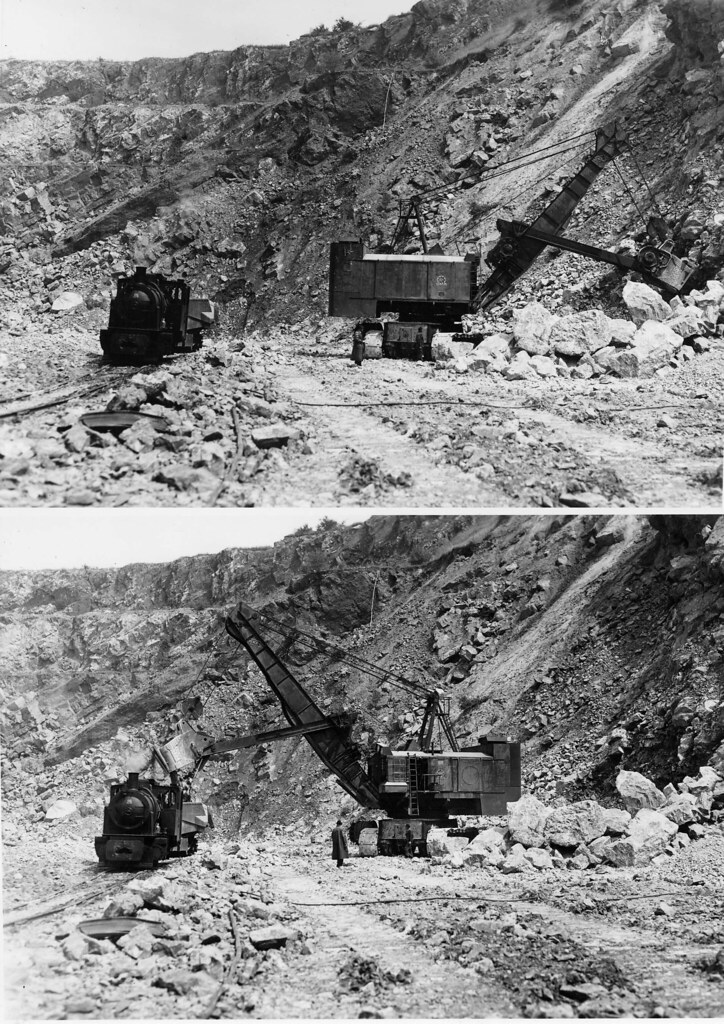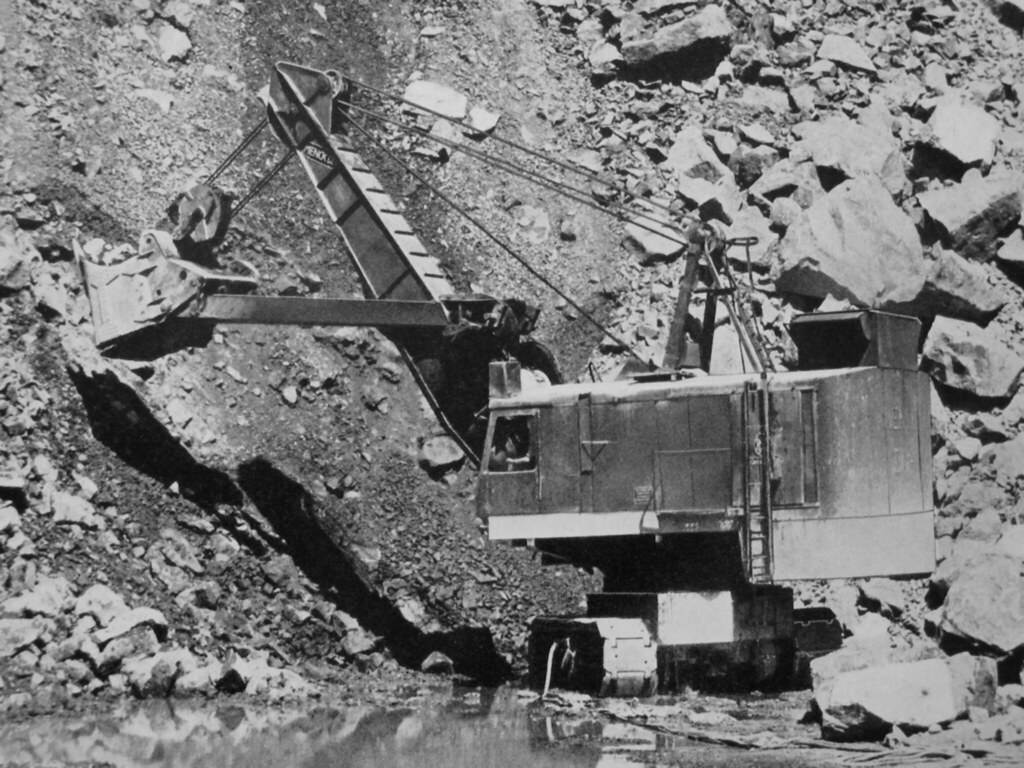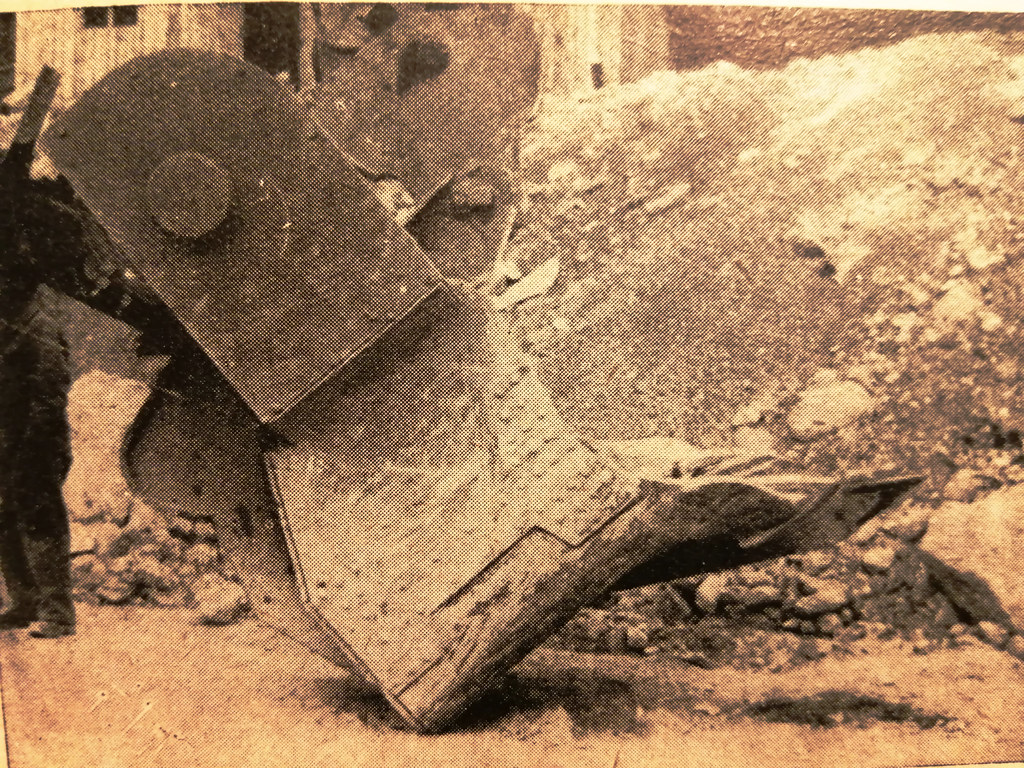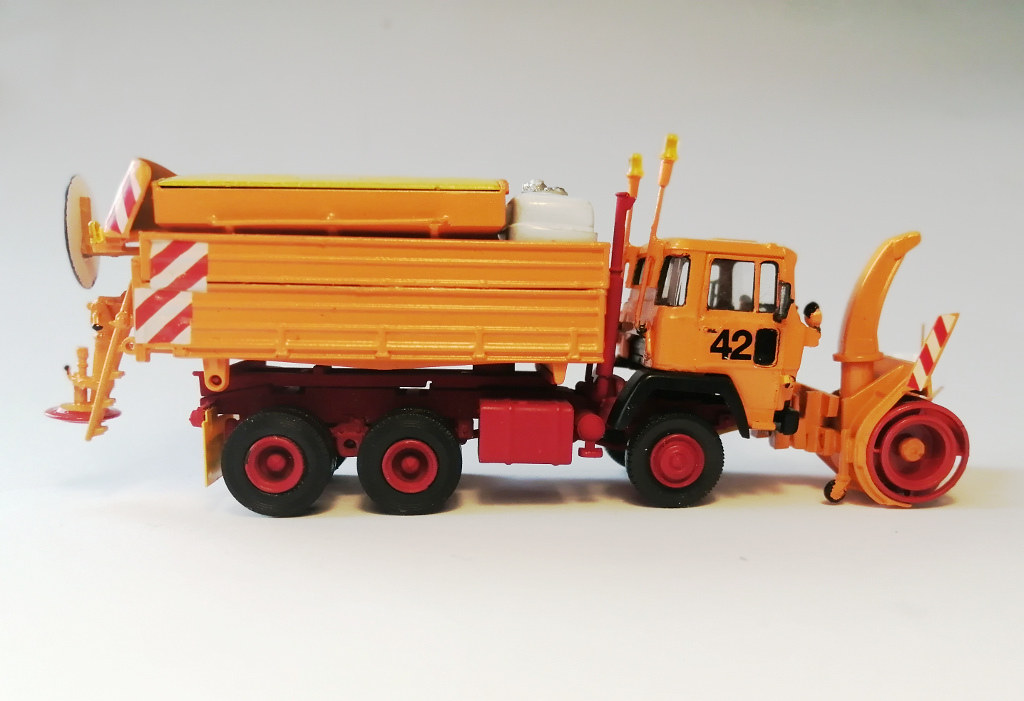|
|

Rank: Advanced Member
Groups: Member
Joined: 4/3/2003
Posts: 2,197
Location: Rockford,IL.
|
Very nice. Thanks for posting. Ken
|
|
Rank: Advanced Member
Groups: Member
Joined: 7/14/2008
Posts: 247
Location: Germany, CE
|
Thanks, Ken! Now, what we've got here... hmm. An N-Scale model and not even finnished: It's an MENCK Model F quarry shovel from the 20ies. A machine of the 300 ton class with an 6,7 cy dipper. Mainly for ripping lime stone.  MENCK MODELL F 001 MENCK MODELL F 001 by FatCatGotHot
|
|
Rank: Advanced Member
Groups: Member
Joined: 7/14/2008
Posts: 247
Location: Germany, CE
|
Hey mates, almost finished - a dedicated 90 ton MENCK M251 rock ripping shovel. 
M251 Heavy Duty ripper dipper 010 by FatCatGotHot
M251 Heavy Duty ripper dipper 011 by FatCatGotHotIt's the 1/87 NZG model combined with a 1/60 Wiking face shovel attachement. A lot of work went into it. 
M251 Heavy Duty ripper dipper 004 by FatCatGotHotHere you can see this dipper means business! It's made for ripping slag and such. 
M251 Heavy Duty ripper dipper 001 by FatCatGotHotAlso the base machine recieved some customization. 
M251 Heavy Duty ripper dipper 005 by FatCatGotHot, yes, we know, on Flickr... Have fun! Cheers, Max
|
|

Rank: Advanced Member
Groups: Member
Joined: 10/4/2005
Posts: 990
Location: england
|
Looks good  Those teeth look straight out of a dinosaur's mouth!LOL.Looking forward to finished pics,with cables in place.
|
|
Rank: Advanced Member
Groups: Member
Joined: 7/6/2015
Posts: 1,317
|
That dipper looks great.
Steve
|
|
Rank: Advanced Member
Groups: Member
Joined: 7/14/2008
Posts: 247
Location: Germany, CE
|
Thank you for the feedback! I never found a manufacturer that designed their shovels so much for ripping like MENCK did. Probably because blasting quickly generated "collateral damage" to nearby towns here in Germany. Before the M251 will be weathered, I hought of making some photos of it still factory-fresh. In other words: Just caught this truck yesterday, looks like somthing big is going on in my neighbourhood... 
M251 Heavy Duty ripper dipper 014 by FatCatGotHotCheers, Max
|
|

Rank: Advanced Member
Groups: Member
Joined: 10/4/2005
Posts: 990
Location: england
|
I never found a manufacturer that designed their shovels so much for ripping like MENCK did.
I remember way back in the early eighties,getting a Siku Menck m500h.From then on,I knew they made proper digging machines.Looking at older Menck equipment,shows they were always innovating,many things they patented are now 'standard'.
|
|
Rank: Advanced Member
Groups: Member
Joined: 7/14/2008
Posts: 247
Location: Germany, CE
|
Yeah, i had this very same SIKU toy. My M500H was red and silver. It weven had a small sprocket on the turntable. Pretty cool toy excavator.
|
|
Rank: Advanced Member
Groups: Member
Joined: 4/2/2005
Posts: 648
Location: America
|
Mr. Scholz wrote:I never found a manufacturer that designed their shovels so much for ripping like MENCK did. What do you mean by this? How were Menck cable shovels distinctly different (better for ripping) compared to those from Demag, O&K, Weserhütte, etc.? modelmaniac wrote:From then on,I knew they made proper digging machines.Looking at older Menck equipment,shows they were always innovating,many things they patented are now 'standard'. What innovations are you referring to? The only significant patents I'm aware of were for the scrapedozers and diesel pile hammers. Menck hydraulic excavators were not that great other than the Koehring machines produced under license.
|
|
Rank: Advanced Member
Groups: Member
Joined: 7/14/2008
Posts: 247
Location: Germany, CE
|
Ooooh yeah, Weserhutte! Thanks for chiming in. Now we are talking. I have to say that I was rather aming towards established US-manufacturers like BUCYRUS, P&H, MARION etc. then comparing MENCK to other german brands. In general, Germany is much denser populated then the US and so our quarries are much closer to settlements then in America. And so the walls are much steeper then in american quarries. Of course, also other german manufacturers had to deal with it. DEMAG built some amazing quarry shovels like the U34 and U35, but only until shortly after WW2. With other quarry shovels, DEMAG never had the success like MENCK. Also Weserhutte build big shovels, but no all-electric sepcialized quarry machines like its two direct competitors. In many cases, blasting in quarries here in Germany was forbidden because of proximity to buildings. So ripping was needed, but the narrow quarries then offered a big risk of rock slides. When you want to rip rock with a shovel, you have to get it close to danger. MENCK was the only supplier who really could provide machines suited for ripping under such very severe conditions from the 1920ies onwards. So here the destinct features of MENCKs quarry shovels and why they are so good for ripping: 1. Extremly massive, short and high quarry undercarriage. Puts all upper works as high as possible. So in case of rock slide, it acts like a wave-breaker and can take some serious beating 2. Upper carbody armoured with up to 1/2" of sheet metal. 3. Compared to machine weight, relative small dipper on a long boom/handle combination. The 230 ton MENCK EN had the same reach like a 350 ton MARION, but only a 6 yard dipper. So you keep a nasty, instable wall during ripping as far away as possible. And you concentrate the bail pull on a relative small bucket, which increases ripping force 4. Compared to BUCYRUS quarry shovels, also MENCK had double reduction hoist winch drives. But further the hoist line used a double pulley design. This made the shovels slower compared to US-machines, but offered very high bail pull. 5. MENCK designed specialized ripping teeth for its dippers, often tailored to meet the requirements of a customer. I never saw this on DEMAG, Weserhutte or american machines or elsewere. On international jobs, like hydro powerplants in the Alps in Switzerland and Austria, it showed that US-american shovels were designed rather for speed and efficiency while the MENCKS were much slower, but could work where other shovels had to be withdrawn. In Sweden, a quarry used a Ruston Bucyrus 110 RB next to a MENCK EN. Where it needed 20 seconds cycle time, the EN needed 30 seconds - but the EN could rip material that needed to be blasted when the 110 RB moved in. A 1930ies vintage MENCK Model E during ripping. Note the high undercarriage  Bild 018 Menck-Mod.E-02 Bild 018 Menck-Mod.E-02 by FatCatGotHotA MENCK EN showing its long reach over 105 feet combined when swinging 180°  Bild 031 MENCK EN Rheinkalk Schlagweite Bild 031 MENCK EN Rheinkalk Schlagweite by FatCatGotHotThe EN from Malmoe, the one that was working next to the 110-RB. Picture from collection of T. Andersson  MALMOE MENCK EN Andersson 001 MALMOE MENCK EN Andersson 001 by FatCatGotHotA 165 ton, 5 yard MENCK DN in front of a threatening highwall  Menck-DN-53 Menck-DN-53 by FatCatGotHotAnother DN in a Pozzolana quarry near Rome, had a 3.3 yard dipper on a longer boom. When you can see the passes of its teeth, it's a ripping job.  Bild 047 DN Lava Italien Bild 047 DN Lava Italien by FatCatGotHotBut all my talking, you can concentrate it on the following two pictures: Specialized ripping teeth MENCK developed for a DN and a M250 - who else did this for their shovels?  MENCK Reisssporn DN MENCK Reisssporn DN by FatCatGotHot MENCK Reisssporn M250 MENCK Reisssporn M250 by FatCatGotHotCheers, MENCK-Max
|
|
Rank: Advanced Member
Groups: Member
Joined: 7/14/2008
Posts: 247
Location: Germany, CE
|
Hey mates, saw that my pictures from my first posts got lost. Re-uploaded them.
Cheers,
Max
|
|
Rank: Advanced Member
Groups: Member
Joined: 4/2/2005
Posts: 648
Location: America
|
Hi Max,
That is a lot to respond to and I'm sorry I don't have the time right now to dig out my Menck, Demag, Marion, P&H, etc. brochures and catalogs to respond in detail. I will come back to you on your 5 points in the nest days and the rest as time permits.
|
|
Rank: Advanced Member
Groups: Member
Joined: 7/14/2008
Posts: 247
Location: Germany, CE
|
Hello Weserhutte,
now this is the best I could hope for. Take your time, I posted a lot. As I was publishing an article on Menck quarry shovels, I had it all ready in the pipe. I appreciate your efforts, thanks mate.
With best regards,
Max
|
|
Rank: Advanced Member
Groups: Member
Joined: 4/2/2005
Posts: 648
Location: America
|
I didn't forget about you, Max.
Unfortunately, this is probably not the response you were hoping for. And for what it's worth, it's not the response I originally imagined writing.
What you have posted covers the '30s through the '60s/70s. In my opinion it is simply not possible to generalize anything over that length of time.
If you want to compare a particular Menck shovel, I've probably got the specs of an American machine of the same vintage and bucket size. Then we can try to make a fair comparison. I need to see what Menck brochures I actually have and that will help, but there is no extra time right now to unpack them.
I can also tell you for certain that I have never personally seen a cable shovel with grafted extra long teeth, but I seem to remember seeing a photo of a Northwest with a similar design. Maybe it was in one of the Northwest history books. One of the authors used to come on here and may see this (paging Mr. Torres). He could easily confirm or refute this so I will send a PM.
|
|
Rank: Advanced Member
Groups: Member
Joined: 7/14/2008
Posts: 247
Location: Germany, CE
|
Hello Weserhutte,
thanks for the reply! If we want to focus on the ripping aspect, we should look at shovels from the 30ies/40ies. Since the first DN prototype was built 1938 (or so), we can use this as a starting point. As I have a brochure of a 120-B dated 1930, we can compare measurements, dipper length and capacity and so on. From the early 1960ies on, Menck shovels were used more and more for loading blasted material and this changed the design of the dippers. But this will be trated later.
Best regards,
Max
|
|
Rank: Advanced Member
Groups: Member
Joined: 4/2/2005
Posts: 648
Location: America
|
If you have brochures of competitive shovel of the same vintage (within 3-5 years), that would be a great place to start if enough information is there.
I just don't have the free time to dig my stuff out at present. I'm lucky to look at this forum weekly.
|
|
Rank: Advanced Member
Groups: Member
Joined: 7/14/2008
Posts: 247
Location: Germany, CE
|
Hi Weserhutte, I'm still glad about your feedback, with or without catalogue material. Best basis for are comparison are technical drawings. Thanks a lot to Wolf from the IghB technical archive who provided the MENCK DN drawing. http://www.ighb.de/The drawings are in same scale. The 120-B was introduced with a riveted boom in 1925 as a 4-yard shovel weighing 351,300 lbs. Arround 1935 it recieved a welded boom and was upgraded to a 5-yard machine, so it grow from 3 to 3,8m³, but weight remained the same. The DN was introduced as a 3.2m³ in 1938, but soon was improved to 3.6m³, rising it's weight from 309,000 to 330,000 at the end of WW2. So both machines are roughly in the 150 ton class. Ripping rock out of a bench differs from loading shot rock in the way that you have to get your shovel close to a high wall that you are destabilizing. You can compare it to demolition work on buildings to some aspect. While both shovels had the same reach of 13.4m/44feet, the DN could reach one meter higher: Its highest digging reach was 11.5 meters compared to 10.5 meters of the 120-B.  Vergleich BE120-B M&H DN 001b Vergleich BE120-B M&H DN 001b by FatCatGotHotIn this drawing, I marked the centerline of rotation of the upper works. You can also see that the undercarriage on the 120-B was the widest part of the shovel, on the DN it had the same width like the upper works. Both shovels had about the same diameter of rollers, but the 120-B had on further axle and lower ground pressure. On the DN, each wheel was designed to carry the whole weight of the machine, but I have no data on this for the 120-B. Both shovels had double-reduction hoist winches, but the DN also had a double pully. On the 120-B, both ends of the hoist line were attached to the drum, but there was no pulley reduction. Its boom head with large wheels offered higest efficiency. Bail pull on the 120-B was about 42 tons for a 5 yard dipper and 55 tons on the DN for a 4.75 yard dipper. The 120-B had a 187 1/2 HP (yes, B-E was that exact in the specs) hoist motor, the DN a 246 1/2 HP hoist motor. But the 120-B was Leonard-Ward control and reached about 20-25 seconds cycle time. It was a fast, high-performance loading shovel. Speed was not that important on the DN. It had AC motors with 3-step controls and needed 30 seconds cyle time, 50% slower than the Bucyrus. But under the dangerous conditions during ripping, speed was often not of interest.  50B00111000_Dreimotoren_Elektro_Löffelhochbagger_DN GIMP 004 50B00111000_Dreimotoren_Elektro_Löffelhochbagger_DN GIMP 004 by FatCatGotHotOn the last drawing you can see that the machinery deck of the DN was 2 feet higher then the one of the 120-B (red line). Also the undercarriage was higher (yellow line). What is sitting high is mostly out of danger in case of a rockslide - that was one of the philosophies of Menck's design. The sprocket on the Bucyrus has ten teeth compared to eight on the DN - and you can really see that the tracks on the DN are designed very heavy. They, together with the heavy wheels, were the best protection for the UC during rockslides. We believe that 33-40% of the machine weight on a DN was in the UC. Some of the driveline parts on the 120-B were unprotected, while on the DN, everything was covered.  Vergleich BE120-B M&H DN 003 Vergleich BE120-B M&H DN 003 by FatCatGotHotI was also chatting with MarioT on the specialized ripping buckets/teeth Menck used. He stated that he never saw anything like it on US-made shovels. I do not want to say that the 120-B was a bad ripping shovel. By far not, it absolutely revolutionized the mining shovel industry. The high quality cast steel construction of the big Bucyrus, made of best steel alloys available, was something Menck only could dream about. The DN was welded from normal construction steel for most of the parts, cast steel alloys only were other solutions were not possible. But I hope I can illustrate how Menck used clever design to cope with the dangerous task of ripping rock.
|
|
Rank: Advanced Member
Groups: Member
Joined: 7/14/2008
Posts: 247
Location: Germany, CE
|
Some progress on my aircooled, Deutz-driven Magirus 6x6 Autobahn snowblower. First time I have everything together. I'm always shocked to see all the dents and faults of my customs the first time I look at them on a photo. But after I time, I start to weather it and to enjoy what I have built. After all, it's 1/87.  Magirus Autobahn Schneefräse 008 Magirus Autobahn Schneefräse 008 by FatCatGotHot Magirus Autobahn Schneefräse 010 Magirus Autobahn Schneefräse 010 by FatCatGotHot Magirus Autobahn Schneefräse 009 Magirus Autobahn Schneefräse 009 by FatCatGotHotCheers, Max
|
|
Rank: Advanced Member
Groups: Member
Joined: 7/14/2008
Posts: 247
Location: Germany, CE
|
|
|
Rank: Advanced Member
Groups: Member
Joined: 7/14/2008
Posts: 247
Location: Germany, CE
|
Some out of the category "Quick and Dirty": I customized the NZG Frutiger SR2001. Weathering is not complete, but so far, I shot some dirt pics good for sharing here. how do you think about scrapedozers? Yes, the SR2001 is not German, but a Japanese NISSHA SR280 P2, imported by the Swiss company Frutiger. But the concept of the scrapedozer is one of the few real German contributions to the earthmoving world. And it was developed by MENCK during WW2, so it's a good addition to this thread. It all started with this nice white painted SR2000 I found in a brochure:  weisse SR2000 weisse SR2000 by FatCatGotHotSo, the white paint job made me think about a UN version used in humanitarian tasks - after all, the scrapedozer fits into large air transports and can work in water up to 6 feet deep.  IMG_20200702_180545 IMG_20200702_180545 by FatCatGotHotWhen you work in water, have a tow cable already mounted to the rear hitch.  IMG_20200703_172925 IMG_20200703_172925 by FatCatGotHotDepending on model and transport distance, a single scrapedozer can move between 2000 and 5000 cy a day. Their performance is comparable to one excavator, 3 dump trucks, and one dozer.  IMG_20200703_171113 IMG_20200703_171113 by FatCatGotHot IMG_20200703_172953 IMG_20200703_172953 by FatCatGotHot IMG_20200703_172859 IMG_20200703_172859 by FatCatGotHotCheers, Max
|
|
|
Guest |
